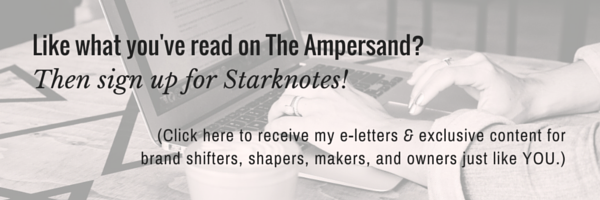A couple of weeks ago I was doing my normal morning blog perusal when I came across a post that caught my eye. Penned by a team of branding entrepreneurs, the blog was aboutthe importance of originality. The writers shared about a recent experience they had with a copycat competitor. They used the incident to reprioritize originality in their business and share this wisdom with their community. I totally get it. It is super annoying to place creative energy into something only to have someone else ride on your coattails. But, just the same, something about the post irked me.
Here’s my 15-second rant:
We live in an age where the adage “there is nothing new under the sun” rings more true than ever. With a quick search of The Google we can know exactly what our competitors are up to, down to how much they make, who they buy from [and at what prices], and details of their so-called “proprietary” processes.
Here’s my current take on originality:
It’s cool, but it’s fleeting. You can’t stop investing in R + D, and developing unique offerings, but you also can’t hang your hat on these things either. The barriers to entry, particularly in knowledge-based businesses, are just too low these days. You’ll have your 15 minutes, and then you’ll be back to the drawing board.
So what’s the alternative?
I don’t have definitive answers, but I've recently been very taken by the concept of authenticity.
Authenticity happens when you realize that what's most useful to the people you serve is your truth.
There is exactly one person in the world who holds the precise mix of know-how, creativity, experience, humor, insight, and worldview that you have. Your authentic self is inherently original! No one can rip you off and do you justice. They can duplicate your products and services, but they can never duplicate you and what you bring to bear on your creation.
So how do we do it? How do we write, design, sell and build our brands authentically? Here are three practices I’ve been implementing recently:
3 Simple Practices for Creating Authentically
1. Filter, filter, filter!
I'm a fact-finder by nature. Before I take action, I research and read until I am sure I want to go in a particular direction. When it comes to my own business, I read voraciously. It's helpful to be keyed-in to what is going on in the branding and content worlds, but the downside is that I often grapple with immense information overwhelm.
It's hard to create authentically when you're deluged with other people's ideas.
To combat this, some of us need to go Marie Kondo on our social feeds!
I'm becoming a ruthless tidying-er when it comes to thethings I allow into my inbox or blog reader. The content that I value brings me joy and inspiration rather than "10 sure-fire ways to make a million bucks this month." Catch my drift?
When I do read something of someone else's that inspires me or helps to further an idea that I've been noodling, I jot down quotes and paraphrases and always attribute the source accordingly because authenticity and plagiarism aren't friends.
2. Ask Reflective Questions.
When I sit down to write my own material, I almost always start by asking myself a series of questions. Here are the ones that led to what I'm sharing today:
- What's annoying me?
- What have I learned recently that can help my followers?
- How can they implement it?
You'll notice these are not earth-shattering questions, but they do help to uncover creative ideas that stem from my actual life and business as opposed to the make-believe life I can end up living vicariously if I'm not careful.
When you sit down to create, try the discipline of looking inward first before you look out to what the competition and market is doing. You can always adapt your authentic ideas, but it is hard to come up with them when you're taking your cues from other people's journeys.
3. Create for Exactly One Person.
This is a fun one. I recently watched an interview with the writer Elizabeth Gilbert [of Eat, Pray, Love fame] where she talks about her number one trick for writing [starts at minute 10.30]. It's simple but so profound: know who you are writing to.
The idea is to choose a person, not a demographic, archetype, or NRS social grade, -- someone you actually know who is representative of your target audience -- and create as if your product was going to be used by only them.
Gilbert's novel, The Signature of All Things, was written to her elementary school teacher, Miss Carpenter. Whenever Gilbert had to make a decision about what went in the book she would ask herself, "does Sandy Carpenter care about this?"
I think this is such a powerful exercise for cultivating creative authenticity no matter what you do! Whether you are blogging, sketching, or engineering, it is difficult to be inauthentic when you are creating for someone you actually know -- someone with real needs, hopes, curiosities, and annoyances. I've found that creating for someone [as opposed to a generic group of people] is a great filtering mechanism for my best ideas and lends a human quality to the the final product. Win-win.
So that's it! These are the habits I've been adopting recently to help me shoot for authenticity rather than stress about being original. Do you feel me on any of these? Undoubtedly, it's important to stand out from the crowd in business, but in the end, I believe that the best way to connect with our customers is by creating from who we actually are.
-------
Today's post was adapted from the October Starknotes email, the monthly missives where I get a little bit deeper about the highs and lows of life from the creative entrepreneurship front.







